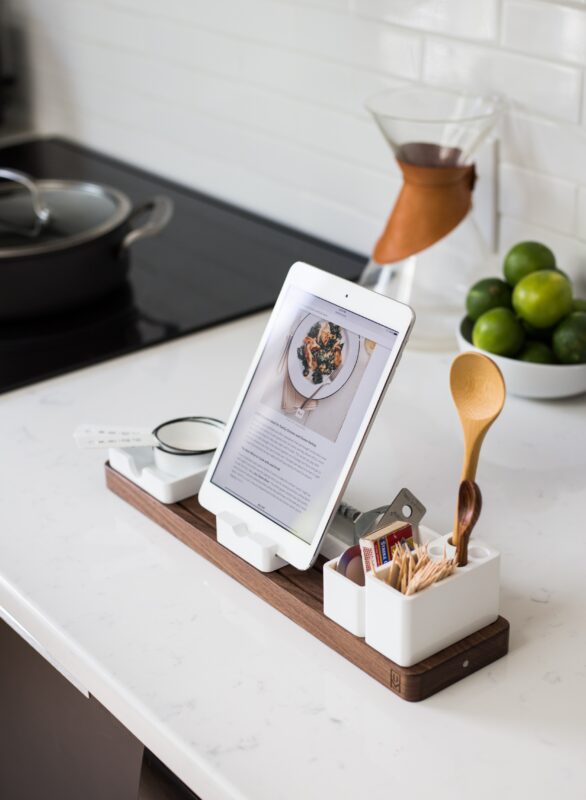How Do Smart Meat Thermometers Ensure Perfect Cooking
Have you ever wondered how professional chefs always manage to cook meat to perfection, with every bite bursting with flavor and juiciness? The answer lies in the use of smart meat thermometers. These innovative kitchen gadgets take the guesswork out of cooking meat by providing precise temperature readings and real-time alerts, ensuring that your steak, chicken, or roast is cooked just the way you like it. In this article, we will explore how smart meat thermometers work and how they can revolutionize your culinary skills. Get ready to take your cooking to the next level with the help of this technological kitchen companion.
Understanding Smart Meat Thermometers
Definition of smart meat thermometers
Smart meat thermometers are innovative kitchen devices that are designed to monitor and measure the internal temperature of meat while it is being cooked. Unlike traditional thermometers, smart meat thermometers are equipped with advanced technology that allows for wireless connectivity and remote temperature monitoring. These devices provide real-time temperature readings and alerts, making it easier for home cooks and professional chefs to achieve perfectly cooked meat every time.
Components and structure of smart meat thermometers
A typical smart meat thermometer consists of several components. The main component is the probe, which is inserted into the meat to measure the internal temperature. The probe is connected to a transmitter or wireless module, which sends the temperature data to a receiver or mobile application. The receiver or app displays the temperature readings and allows users to set desired temperature targets and receive alerts. Some smart meat thermometers may also include additional features such as timers, temperature history tracking, and recipe integration.
Varieties of smart meat thermometers
There are various types of smart meat thermometers available in the market, each offering unique features and functionalities. Some models use Bluetooth technology to connect with a smartphone or tablet, while others utilize Wi-Fi connectivity for long-range monitoring. Additionally, some smart meat thermometers come with multiple probes, allowing for simultaneous monitoring of different pieces of meat or different temperature zones within a single piece of meat. The variety of smart meat thermometers available caters to different cooking needs and preferences.
How Smart Meat Thermometers Work
Measurement of cooking temperatures
The primary function of a smart meat thermometer is to measure the cooking temperature of meat accurately. The probe of the thermometer is inserted into the thickest part of the meat, avoiding any bones or fatty areas. As the meat cooks, the temperature of the internal portion increases, and the probe detects these changes. The temperature readings are then transmitted wirelessly to the receiver or mobile app, providing real-time updates on the cooking progress.
Use of wireless technology in data transmission
Smart meat thermometers rely on wireless technology to transmit temperature data from the probe to the receiver or mobile app. Bluetooth and Wi-Fi are commonly used wireless protocols in these devices. Bluetooth-enabled smart meat thermometers allow for short-range connectivity, typically within a range of 100 feet. On the other hand, Wi-Fi-enabled thermometers can transmit temperature data over longer distances, allowing users to monitor the cooking progress remotely, even from outside the home.
Interpretation of temperature readings
Once the temperature data is received by the receiver or app, it is interpreted and displayed in a user-friendly format. Smart meat thermometers often provide temperature readings in both Celsius and Fahrenheit, catering to different user preferences. Additionally, many devices offer customizable temperature alerts, where users can set specific temperature targets for different types of meat and receive notifications when the desired temperature is reached. The interpretation of temperature readings is crucial for ensuring perfectly cooked meat.

This image is property of images.unsplash.com.
Setting Up Smart Meat Thermometers
Step by step guide to set up
Setting up a smart meat thermometer is a relatively simple process. First, ensure that the device is charged or has fresh batteries. Next, insert the probe into the meat, making sure it is placed in the thickest part without touching any bones or fat. Switch on the transmitter or wireless module and ensure that it is paired with the receiver or mobile app. Follow the manufacturer’s instructions to establish the connection and configure any desired settings, such as temperature alerts. Once the setup is complete, the smart meat thermometer is ready to use.
Setting up alerts and timers
Smart meat thermometers offer the convenience of setting up alerts and timers to notify users at specific cooking milestones. To set up alerts, users can define temperature targets based on the desired level of doneness for different types of meat. For example, medium-rare steak may have a target temperature of 135°F. Once the meat reaches the set temperature, the device will send an alert, indicating that it is ready. Timers can also be set to keep track of cooking duration and ensure timely preparation.
How to calibrate for accuracy
Calibration is an essential step in ensuring the accuracy of smart meat thermometers. Some devices come pre-calibrated from the manufacturer, while others may require manual calibration. To calibrate a smart meat thermometer, it is recommended to use the ice bath method. Fill a glass with crushed ice and a small amount of water, then insert the probe into the ice bath, ensuring it does not touch the sides or bottom of the glass. The thermometer should display a temperature close to 32°F. If it doesn’t, follow the manufacturer’s instructions to adjust the calibration.
Using Smart Meat Thermometers
Where to place the thermometer in the meat
Proper placement of the smart meat thermometer is crucial for accurate temperature readings. The probe should be inserted into the thickest part of the meat, away from any bones or fatty areas. For example, when cooking a whole chicken, it is best to insert the probe into the breast or thigh, avoiding the bone. This ensures that the temperature reading reflects the doneness of the meat rather than the bone or fat content, resulting in perfectly cooked meat.
Monitoring temperature remotely
One of the standout features of smart meat thermometers is the ability to monitor the cooking temperature remotely. With Wi-Fi-enabled devices, users can connect their smartphones or tablets to the thermometer and access real-time temperature updates from anywhere. This allows for flexibility in multitasking or attending to other activities while the meat is cooking. Remote monitoring ensures that you can keep a close eye on the progress without having to be physically present in the kitchen.
Interpreting the different readings
Smart meat thermometers provide various temperature readings, which can sometimes be confusing for users. The most fundamental reading is the current temperature, which indicates the internal temperature of the meat at any given time. Other readings may include the target temperature, which is the desired temperature set by the user, and the alarm temperature, which triggers an alert when reached. Understanding and interpreting these different readings allows users to monitor the progress of their cooking and make informed decisions based on their desired level of doneness.

This image is property of images.unsplash.com.
Accuracy of Smart Meat Thermometers
Factors affecting accuracy
Several factors can influence the accuracy of smart meat thermometers. The placement of the probe is crucial, as inserting it into bones or fatty areas can result in skewed readings. Additionally, the calibration of the device plays a significant role in ensuring accuracy. Failure to calibrate the thermometer correctly can lead to inaccurate temperature readings. Finally, it is essential to consider the ambient temperature and the cooking method being used, as different cooking environments may impact the overall accuracy of the thermometer.
How to ensure accuracy
To ensure the accuracy of smart meat thermometers, it is important to follow proper calibration procedures and regularly check the device for any signs of malfunction. Calibrating the thermometer before each use, especially if it has been dropped or exposed to extreme temperatures, helps maintain accuracy. It is also recommended to use the thermometer in appropriate cooking environments, avoiding direct contact with flames or excessive heat sources. Regularly cleaning and inspecting the device for any damage or wear is another way to ensure accurate temperature readings.
Difference in temperature readings between smart and traditional thermometers
Smart meat thermometers generally provide more accurate temperature readings compared to traditional thermometers. This is primarily due to the advanced technology and precision engineering that goes into the design of smart meat thermometers. Traditional thermometers often require frequent manual checks, which can result in heat loss and inaccurate readings. Smart meat thermometers, on the other hand, provide real-time temperature updates without the need to open the oven or grill, allowing for better temperature control and more consistent cooking results.
Advantages of Smart Meat Thermometers
Reduced chances of undercooking or overcooking
One of the significant advantages of smart meat thermometers is their ability to reduce the chances of undercooking or overcooking meat. By accurately measuring the internal temperature, these devices ensure that the meat reaches the desired level of doneness without the risk of being undercooked and unsafe to eat or overcooked and dry. With precise temperature readings and convenient alerts, users can achieve perfectly cooked meat, resulting in a more enjoyable dining experience.
Improved safety in handling meat
Smart meat thermometers contribute to improved safety in handling meat during the cooking process. By providing real-time temperature updates, these devices allow users to monitor the internal temperature of the meat without the need for frequent manual checks. This reduces the risk of cross-contamination and the spread of foodborne illnesses. Additionally, by avoiding guesswork and relying on accurate temperature measurements, users can ensure that the meat is cooked to the appropriate temperature, eliminating any health risks associated with undercooked meat.
Ease and convenience in use
Smart meat thermometers offer unparalleled ease and convenience in cooking. With wireless connectivity and remote monitoring capabilities, users can effortlessly multitask and attend to other activities while their meat is cooking. The ability to set up custom alerts and timers simplifies the cooking process and eliminates the need for constant attention. Additionally, many smart meat thermometers come with user-friendly interfaces and intuitive mobile apps, making it easy for both novice and experienced cooks to navigate and utilize all the features.

This image is property of images.unsplash.com.
Limitations and Troubleshooting Smart Meat Thermometers
Identified problems with smart meat thermometers
While smart meat thermometers offer numerous benefits, they are not without their limitations. One common problem is connectivity issues, especially in Wi-Fi-enabled thermometers, where signal strength and range can affect the performance. Another potential issue is battery life, as some devices may have shorter battery spans, requiring frequent recharging or battery replacement. Users may also encounter difficulties with app compatibility and software glitches, which can impact the overall user experience.
Proposed solutions and troubleshooting
To overcome connectivity issues, it is advisable to ensure that the smart meat thermometer and the receiving device are within the recommended range for optimal signal strength. Users can also try repositioning the thermometer or adjusting their Wi-Fi settings to improve connectivity. Regarding battery life, it is important to follow the manufacturer’s instructions for battery conservation, such as turning off the device when not in use. App compatibility and software glitches can be resolved by updating the app or reaching out to customer support for troubleshooting assistance.
Alternative use if malfunction occurs
In the event of a malfunction or technical issues with a smart meat thermometer, there are alternative methods of ensuring accurate temperature measurements. Traditional meat thermometers, such as instant-read thermometers or probe thermometers, can be used as a backup. These devices may not offer the same level of convenience as smart meat thermometers, but they can provide reliable and accurate temperature readings when needed.
Maintaining and Cleaning Smart Meat Thermometers
Cleaning procedures
Proper cleaning of smart meat thermometers is essential to ensure food safety and maintain optimal performance. To clean the probe, remove it from the transmitter or wireless module, and wash it with warm soapy water. Avoid submerging the probe in water, as it may damage the internal components. For the transmitter or wireless module, use a damp cloth or sponge to wipe away any residue or spills. Make sure to thoroughly dry all components before reassembling the thermometer.
Maintenance recommendations
Regular maintenance helps extend the lifespan and performance of smart meat thermometers. It is recommended to inspect the device for any signs of wear or damage, such as frayed wires or cracked probes, and replace any faulty components promptly. Storing the thermometer in a cool, dry place when not in use helps prevent moisture damage. Additionally, following the manufacturer’s guidelines for battery maintenance, such as avoiding overcharging or leaving the batteries depleted for extended periods, can prolong battery life and overall device performance.
Longevity and care for optimal performance
Proper care and maintenance are crucial for maximizing the longevity and performance of smart meat thermometers. Avoid exposing the device to extreme temperatures or direct flames, as this can damage the internal components. Handle the device with care, especially when inserting or removing the probe, to prevent bending or breaking. Regularly check the battery life and replace batteries as needed to ensure uninterrupted operation. Finally, periodically update the firmware or software of the thermometer to access the latest features and improvements offered by the manufacturer.
Buyers Guide for Smart Meat Thermometers
Budget considerations for smart thermometers
When considering purchasing a smart meat thermometer, it is important to establish a budget based on personal preferences and requirements. Smart meat thermometers are available at various price points, with entry-level models offering basic functionality and more advanced models offering additional features and connectivity options. While higher-priced thermometers may offer more bells and whistles, it’s important to determine which features are essential for your cooking needs and find a device that fits within your budget.
Best models and brands in the market
The market for smart meat thermometers is vast, with numerous models and brands available. Some well-known brands in this space include Weber, ThermoPro, MEATER, and iGrill. These brands are trusted for their reliability, accuracy, and innovative features. Before making a purchase, it is advisable to read reviews and compare different models to find the one that best suits your needs. Online retailers, kitchen specialty stores, and official brand websites are excellent sources for researching and comparing different models and brands.
Where to buy smart meat thermometers
Smart meat thermometers can be purchased from a variety of retailers both online and offline. Online marketplaces such as Amazon, Walmart, and Best Buy offer a wide selection of smart meat thermometers, including different brands and models. Kitchen specialty stores and home improvement stores often have dedicated sections for kitchen gadgets and may carry a selection of smart meat thermometers. Additionally, official brand websites often provide direct purchasing options, ensuring authenticity and access to customer support.
Final Thoughts on Smart Meat Thermometers
Overview of pros and cons
Smart meat thermometers have revolutionized the way we cook meat by providing accurate temperature measurements and real-time monitoring. The advantages of these devices include reduced chances of undercooking or overcooking meat, improved safety in handling meat, and ease and convenience in use. However, they also come with limitations such as connectivity issues and potential software glitches. Understanding the pros and cons of smart meat thermometers allows users to make informed decisions when incorporating these devices into their cooking routine.
Personal experiences and reviews
Personal experiences and reviews play a crucial role in understanding the effectiveness and performance of smart meat thermometers. Many users have reported positive experiences with these devices, highlighting how they have improved their cooking and resulted in consistently perfect meat. Reading detailed reviews from other users can provide insights into specific features, ease of use, and overall satisfaction with different models. It is recommended to explore different sources for reviews, including online forums, cooking blogs, and customer testimonials on retailer websites.
Importance of smart thermometers in modern day cooking
Smart meat thermometers have become indispensable tools in modern-day cooking. With the emphasis on food safety and precision cooking, these devices offer a level of control and accuracy that was previously inaccessible to home cooks. The ability to monitor the internal temperature of meat in real-time, even when not physically present in the kitchen, allows users to multitask, experiment with new recipes, and achieve consistent results. Smart meat thermometers have transformed the way we cook meat and have become an essential companion for anyone passionate about achieving perfectly cooked meals.




